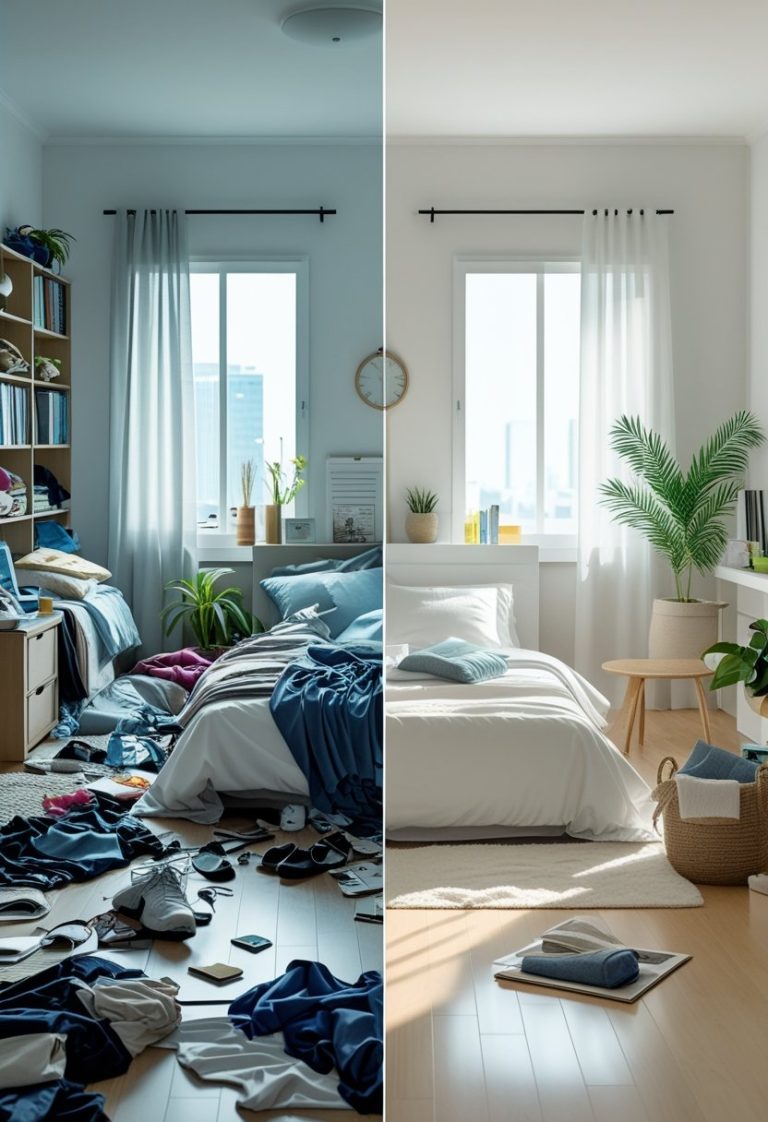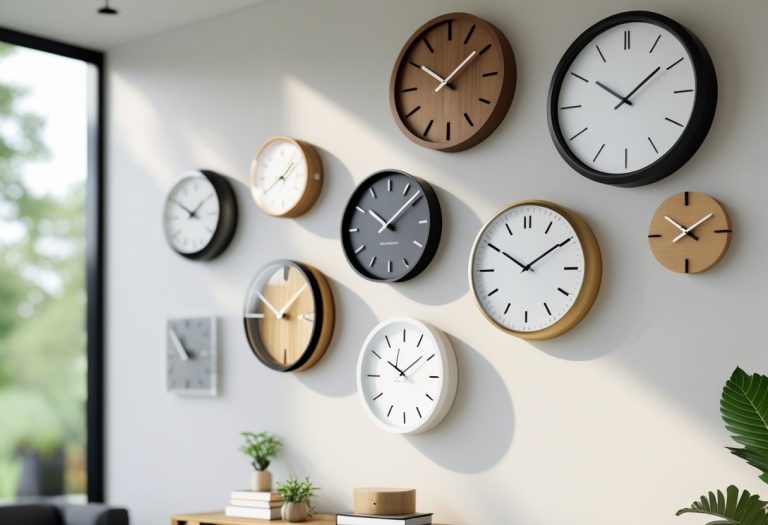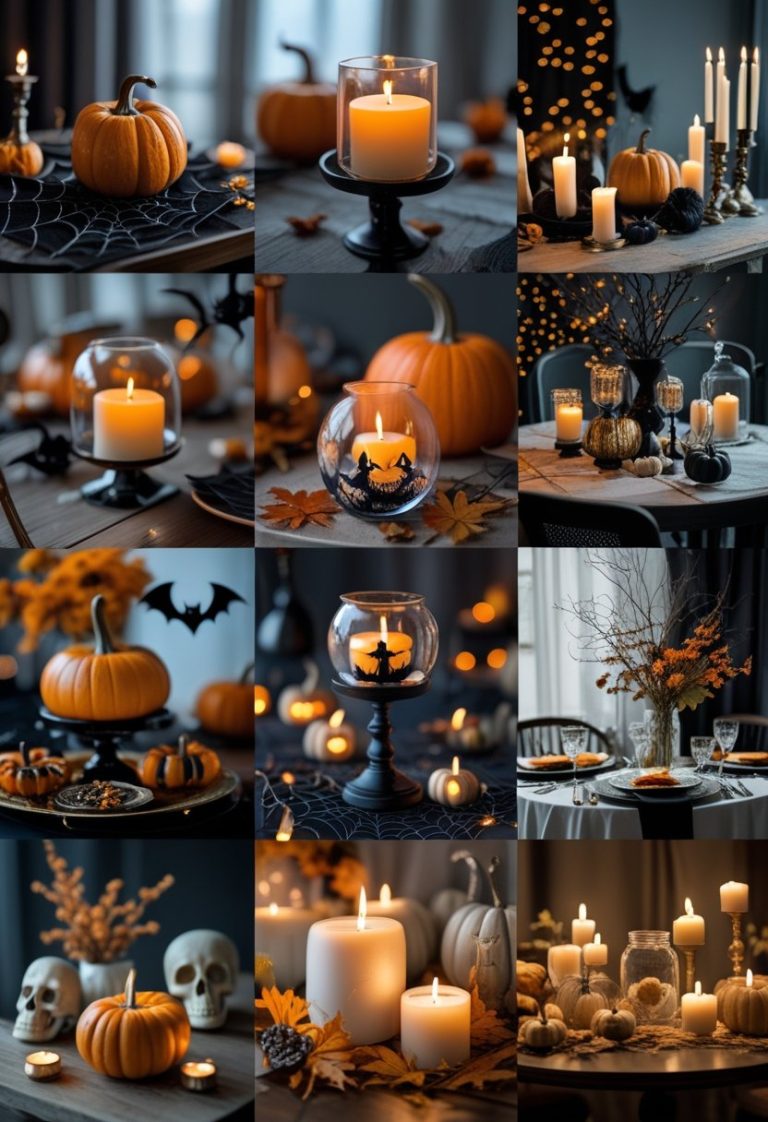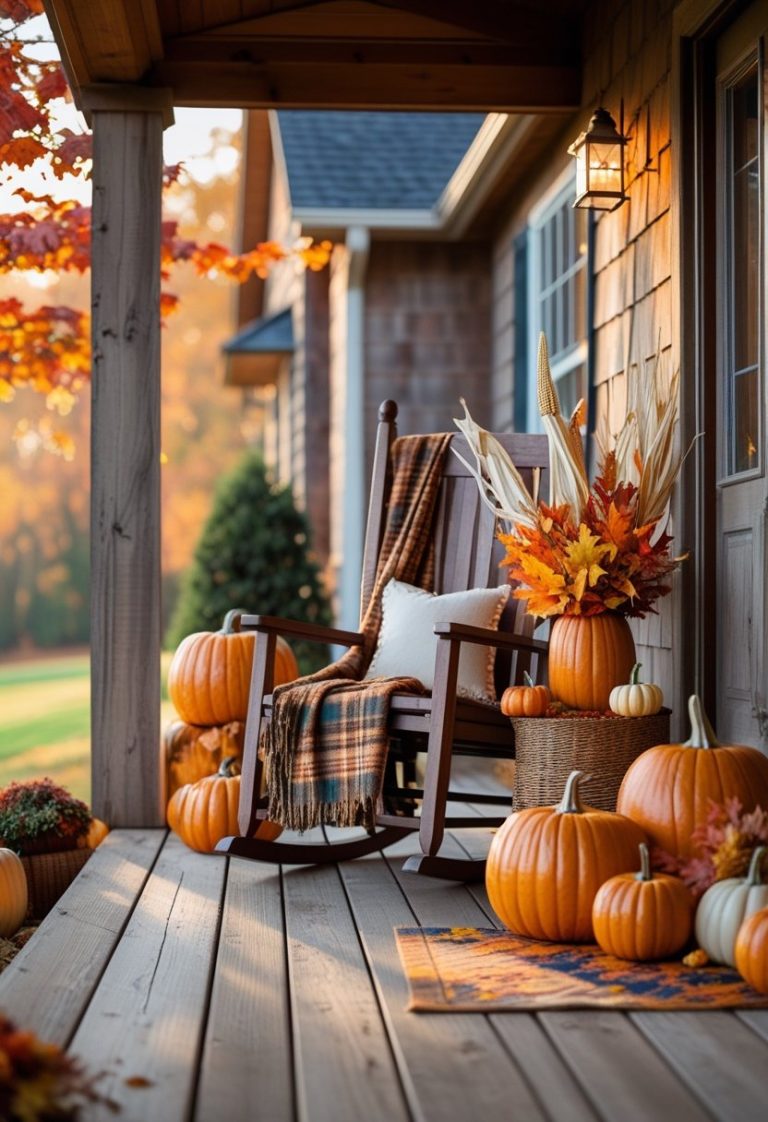Top 2026 Bedroom Trends: Cozy Japandi Style & Earth Tones
Modern bedroom design in 2026 embraces a blend of warmth and simplicity, creating spaces that prioritize comfort and tranquility. Incorporating warm earth tones, soft ambient lighting, and minimalist furniture, these bedrooms reflect a calm, natural aesthetic rooted in Japandi style.
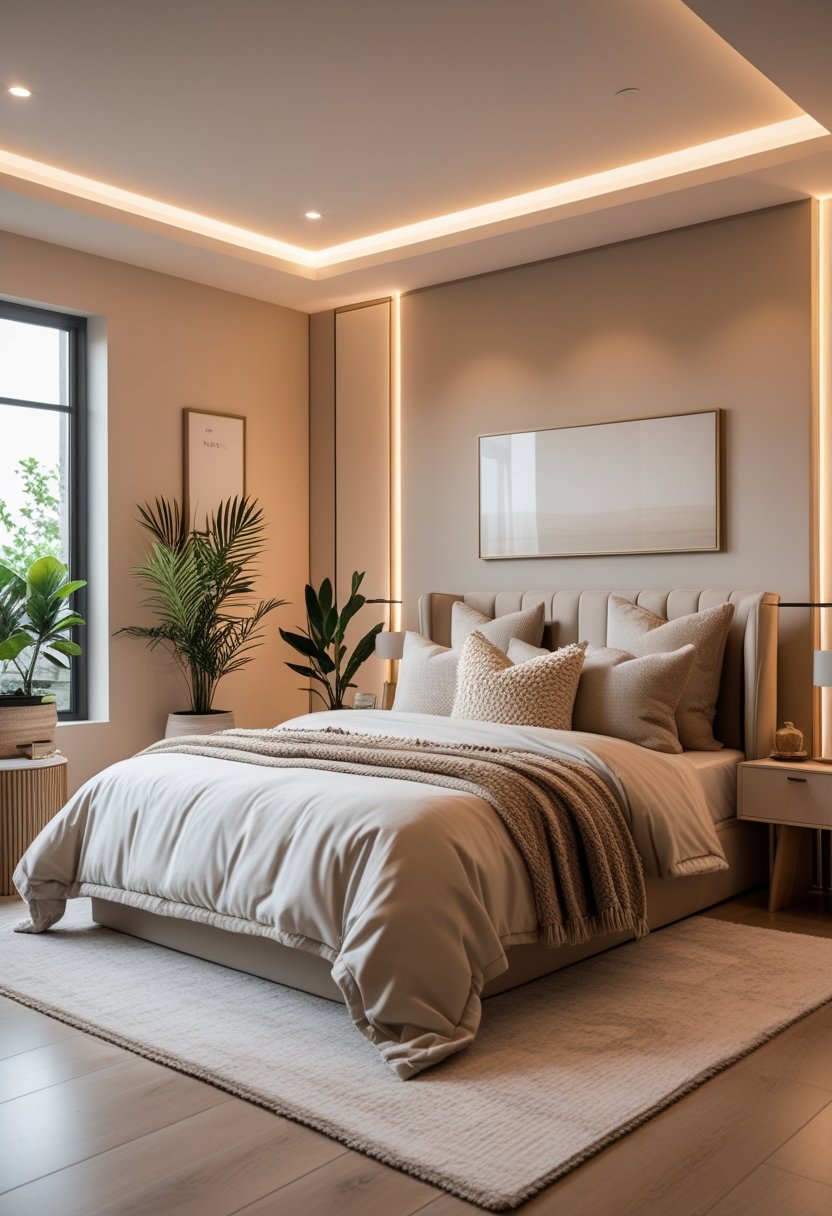
The key to this trend lies in combining organic textures with clean lines to foster a serene, wellness-focused environment that supports relaxation and mental clarity. This approach balances functionality with a cozy atmosphere, making the bedroom a true retreat from daily stress.
Incorporating these elements allows for a personalized space that feels both modern and inviting without overwhelming the senses. Subtle design choices highlight craftsmanship and sustainability, which are central to the 2026 bedroom trends.
Defining the 2026 Modern Cozy Bedroom
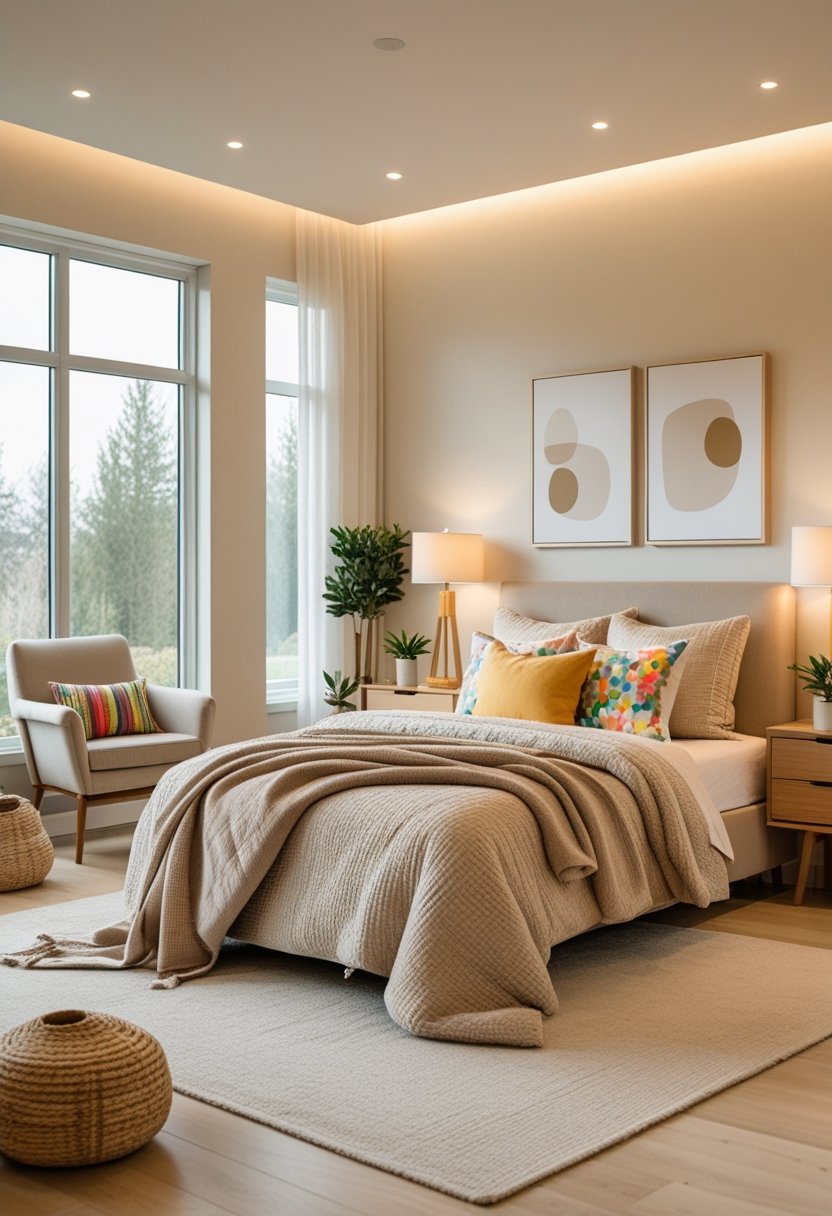
The 2026 modern cozy bedroom emphasizes calm, balance, and natural comfort. It blends clean lines with soft textures and prioritizes thoughtful design choices that enhance tranquility and function. This approach centers on materials, colors, and layouts that promote a restful environment.
Key Elements of Modern Serenity
Modern serenity relies on simplicity and clarity in space. Neutral color palettes such as warm earth tones—including beige, soft browns, and muted greens—form the foundation. These shades create a soothing backdrop that reduces visual noise and supports relaxation.
Furniture choices focus on minimalism with clean lines and sleek forms. Pieces often feature natural wood or matte finishes and avoid excessive ornamentation. Decluttered spaces, with only essential items displayed, help maintain a sense of order and peace.
Lighting plays a critical role, favoring soft ambient sources over harsh overhead lights. Adjustable fixtures and layered lighting create a calm mood while ensuring functionality. Textiles in natural fibers like linen, cotton, and wool add tactile warmth, completing the serene atmosphere.
Japandi-Inspired Comfort Explained
Japandi style combines Japanese minimalism with Scandinavian functionality. It centers on balance, natural materials, and craftsmanship. This fusion emphasizes beauty in simplicity while maximizing practical comfort.
Furniture and decor often feature light, unfinished woods like oak or ash, paired with simple, low-profile designs. Layered textiles—such as wool throws or linen cushions—add softness and invite physical comfort.
Colors remain muted and natural, supporting a calm environment. Accessories focus on handcrafted elements and organic forms, promoting connection to nature. The result is an uncluttered yet inviting bedroom that encourages mindfulness and rest.
The Importance of Wellness-Focused Design
Wellness-focused design prioritizes health and emotional well-being through environmental choices. In bedrooms, this means creating zones that support restful sleep, relaxation, and occasional work or reading activities.
Key features include ergonomic furniture and adjustable lighting systems that follow circadian rhythms. Natural ventilation and air-purifying plants help improve indoor air quality, supporting physical health.
Textures and patterns are selected with intent to soothe rather than overstimulate. Personalization with meaningful objects or travel mementos adds emotional comfort without overwhelming the space. This thoughtful approach makes the bedroom a restorative retreat suited to modern lifestyles.
Warm Earth Tones and Color Palettes
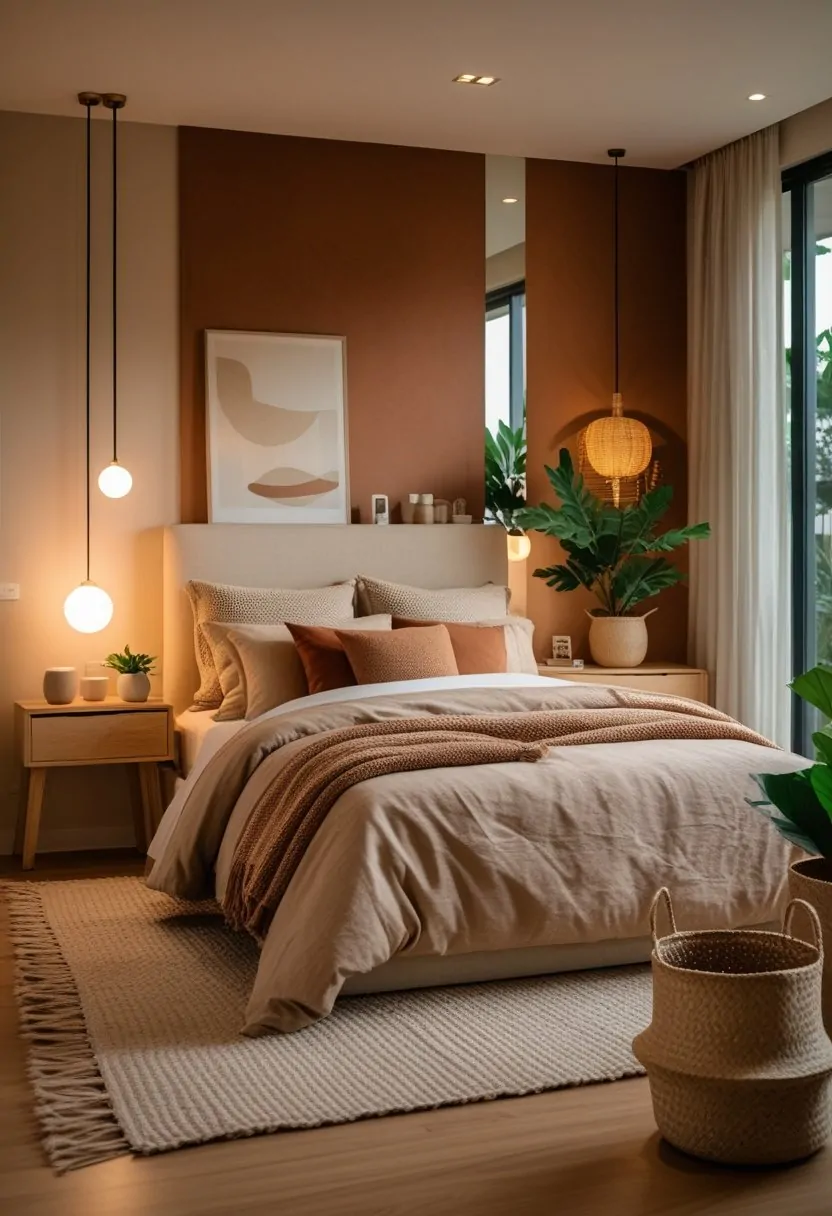
Warm earth tones form the foundation of 2026 bedroom color trends. These hues create a calming atmosphere that invites relaxation and connection to nature. Layering neutrals with subtle color accents adds depth, while nature-inspired shades bring organic warmth and balance to the space.
Top Trending Shades for 2026
The palette centers on rich taupes, soft beiges, and muted terracotta. Deep, near-black tones with brown and charcoal undertones are also rising in popularity, providing an elegant, grounding anchor for bedrooms.
Warm neutrals like warm taupe and soft beige foster a cozy feel without overpowering. Designers highlight moody dark greens and grounding browns as complementary shades that evoke a natural, restorative ambiance.
Brands like Benjamin Moore and Sherwin-Williams emphasize these hues as versatile choices that work well in both minimalist and layered bedroom designs.
Layering Neutrals With Pops of Color
Layering is key to making earth tones dynamic and visually interesting. The base consists of neutral walls and large furniture pieces in beige, cream, or warm gray. Accent colors appear through textiles, art, or smaller furniture.
Pops of muted greens, rust, or burnt orange introduce personality while maintaining a grounded look. These accents break monotony and add warmth without disrupting the room’s serene vibe.
This approach balances simplicity with sophistication, avoiding flatness by using color depth and varied textures to create a cohesive appearance.
Integrating Nature-Inspired Hues
Nature-inspired hues evoke calm and contribute to a wellness-focused environment. Sage green, olive, and soft clay reflect outdoor elements and enhance the bedroom’s organic feel.
Using these tones alongside wood and natural fibers strengthens the connection to nature. The colors harmonize with ambient lighting and organic textures, supporting relaxation.
Subtle metallics with brown undertones can also appear as fixtures or decor, adding elegance while referencing natural minerals. This integration aligns with the broader trend toward mindful, restorative living spaces.
Ambient Lighting and Layered Illumination
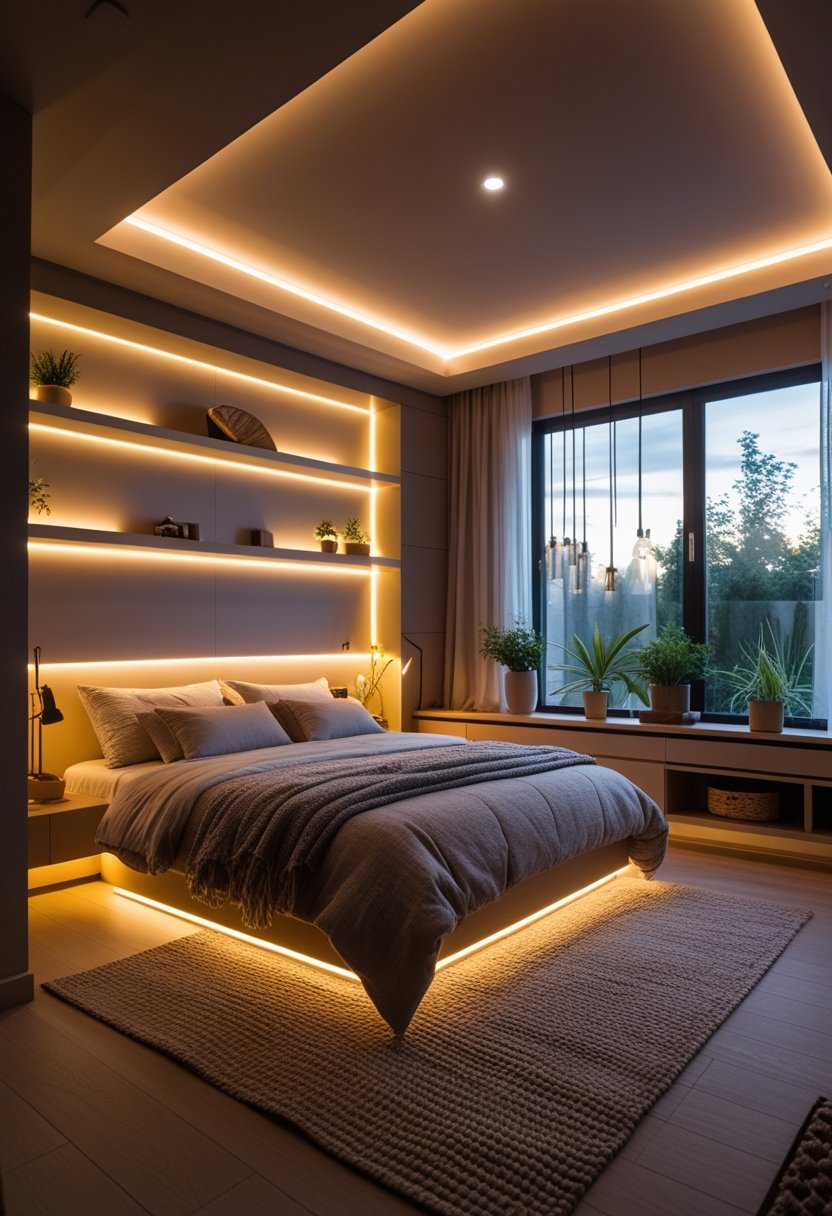
Ambient lighting in 2026 bedrooms focuses on creating a balanced and soothing atmosphere. Multiple light sources work together to provide flexibility, enhance texture, and complement the natural tones and materials typical of modern, cozy spaces. Lighting that adapts to different moods and activities is key.
Soft Lighting Techniques
Soft lighting reduces harsh shadows and creates a warm glow that promotes relaxation. Using diffused lights such as frosted bulbs or fabric lampshades helps achieve this effect. Indirect lighting, including wall sconces or cove lighting, directs light upward or toward walls, softening the overall brightness.
Dimmer switches are essential for controlling intensity and tailoring the ambiance throughout the day. Warm white bulbs, typically around 2700K, support a cozy environment without exhausting the eyes. Layering different soft light sources prevents any single area from becoming overly bright or dull.
Smart and Adjustable Lighting Solutions
Smart lighting integrates technology to customize illumination easily. Voice commands or smartphone apps allow precise adjustment of brightness, color temperature, and timing. This adaptability helps users create optimal conditions for sleep, reading, or relaxation.
Color-tunable LEDs can transition from cooler daylight tones for waking hours to warmer hues in the evening. Automated schedules and motion sensors add convenience and energy efficiency. These solutions also fit with minimalist designs by reducing the need for multiple switches and fixtures.
Accentuating With Decorative Fixtures
Decorative lighting fixtures act as functional art pieces that enhance bedroom character. Sculptural lamps, pendant lights, and unique wall-mounted fixtures serve both purpose and style. Materials like natural wood, stone, or matte metals support the organic, earthy trends.
Positioning accents strategically highlights textures such as wood grain or fabric weaves on furniture and walls. Fixtures with layered designs, including shades within shades or adjustable components, add depth. Choosing statement pieces that blend simplicity with craftsmanship complements the Japandi-inspired aesthetic.
Minimalist and Curved Furniture Innovations
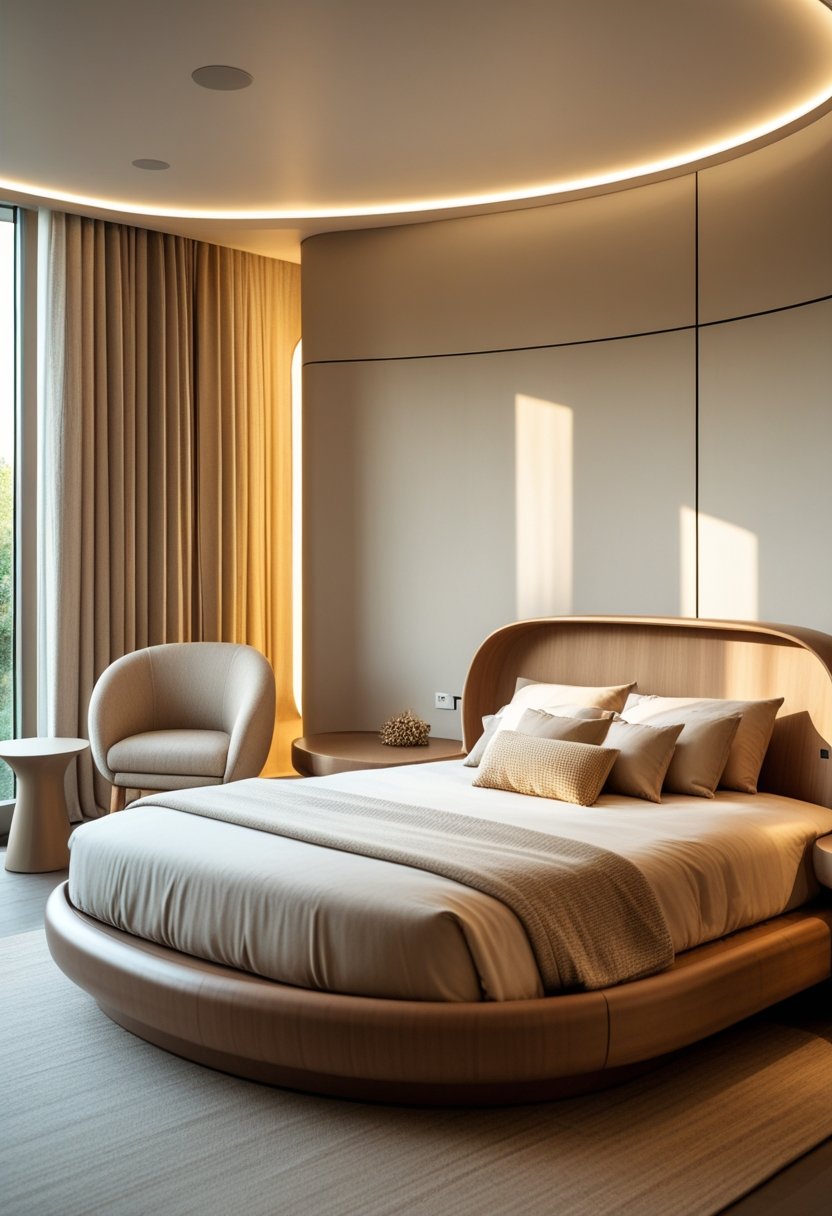
This trend emphasizes clean lines combined with smooth, rounded shapes to create inviting yet understated bedroom furniture. Furniture pieces focus on simplicity, comfort, and subtle artistic details that enhance both form and function.
Choosing Streamlined Bed Designs
Beds in 2026 prioritize simplicity with low-profile frames and minimal ornamentation. Streamlined designs often feature built-in headboards that are flush with the frame, eliminating bulky elements.
Materials such as light wood, matte metal, and upholstered fabrics in earthy neutrals are common. These choices help maintain a clean look while adding warmth and tactile comfort. The use of rounded edges on bed frames softens the overall silhouette without overpowering the room’s aesthetic.
Practicality is key. Storage options like under-bed drawers or platforms integrated seamlessly into the design enhance usability without compromising minimalism.
Incorporating Statement Furniture
Curved accent pieces serve as focal points that balance the bedroom’s minimalism with visual interest. Chairs, benches, or dressers with organic shapes inject softness and movement into the space.
Statement furniture often comes in muted colors or natural materials such as rattan, velvet, or matte ceramic to align with Japandi and earth tone trends. These pieces act as artful contrasts to the sharp geometric lines common in minimalist designs.
When selecting statement items, it is important they remain functional and complement surrounding elements. Oversized or overly complex shapes can disrupt the intended calm atmosphere.
Balancing Functionality and Aesthetics
Furniture must integrate useful features while sustaining the bedroom’s serene ambiance. Modular furniture that can be easily rearranged or adjusted supports versatile living without clutter.
Smart design solutions like hidden compartments, convertible desks, or multi-use seating ensure space efficiency. Rounded shapes are used strategically to reduce sharp corners, making rooms feel more inviting and safer.
The balance lies in selecting pieces that serve everyday needs but adhere to minimalist principles. Careful consideration of materials, scale, and shape ensures a cohesive and calming environment.
Organic Textures and Natural Materials
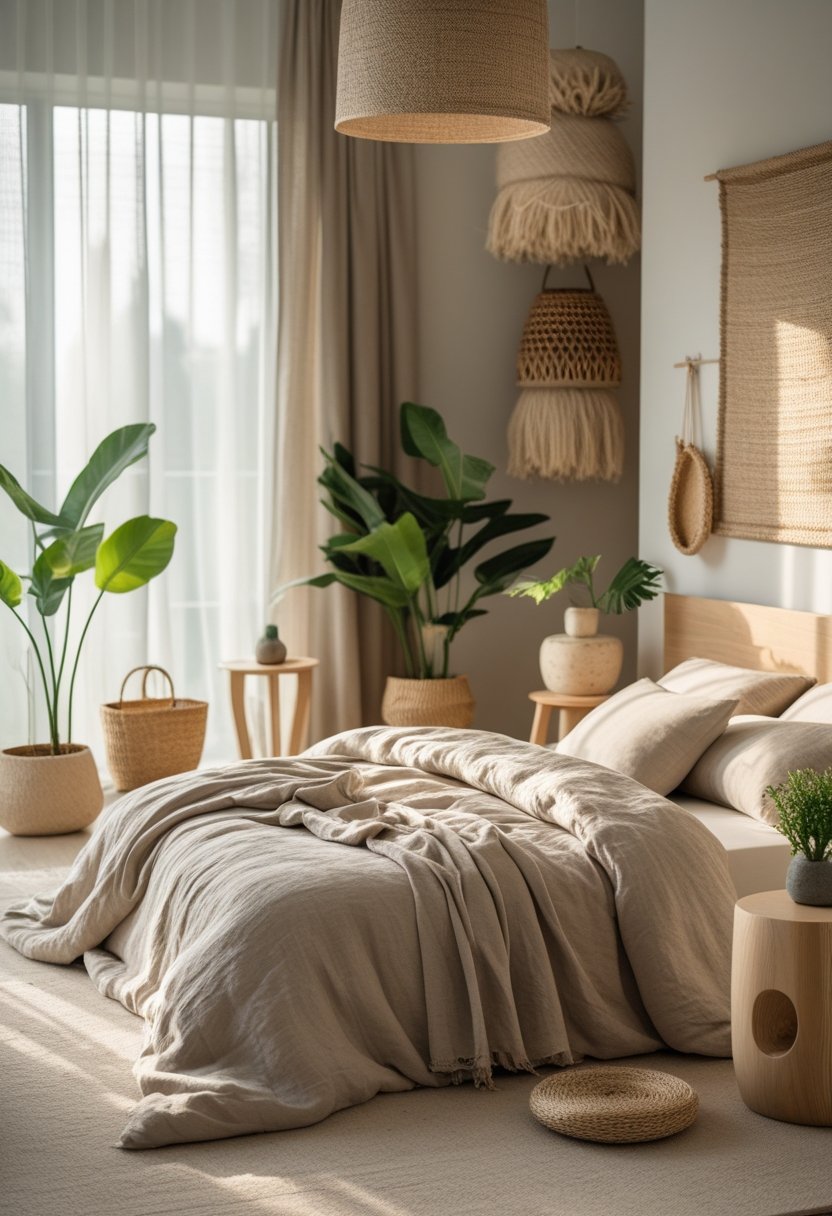
Natural elements bring depth and warmth to a bedroom, blending comfort with sustainability. From carefully chosen fabrics to surfaces, each material contributes to a tactile and inviting environment.
Textile Trends for Bedding and Accents
Bedding in 2026 emphasizes organic fibers such as organic cotton, linen, and hemp, prized for their breathability and durability. These textiles promote a healthy sleep environment by reducing synthetic chemical exposure.
Accents like throw pillows and curtains commonly use handwoven or recycled fabrics, adding texture without sacrificing eco-consciousness. Neutral and earth tone palettes dominate, including shades of beige, muted greens, and soft browns, enhancing the serene feel.
The focus is on softness paired with resilience. Materials are often unbleached or minimally processed, which preserves their natural characteristics and visual appeal.
Sustainable Flooring and Wall Treatments
Reclaimed wood flooring is a prevalent choice, offering both character and ecological responsibility. Its aged finish adds visual warmth and tells a story of reuse.
Wall treatments incorporate natural materials like textured grasscloth wallpaper or clay-based plasters. These options contribute subtle texture and maintain indoor air quality by avoiding synthetic coatings.
Cork flooring is gaining popularity due to sustainability and noise absorption properties. It also adds a soft underfoot feel, enhancing comfort without compromising design.
Layering Rugs and Throws for Comfort
Layering textiles on floors and beds creates visual interest and adds warmth. Rugs made from natural fibers like wool, jute, or sisal provide durable and breathable options.
Throws made from alpaca or organic cotton add softness and functionality, perfect for cooler nights. Combining different textures—smooth linens with coarse woven rugs—builds depth without clutter.
Patterns remain understated, with geometrics and subtle stripes commonly used to maintain a minimalist aesthetic. The layering approach offers flexibility, allowing seasons or moods to influence changes easily.
Wellness and Tranquil Spaces
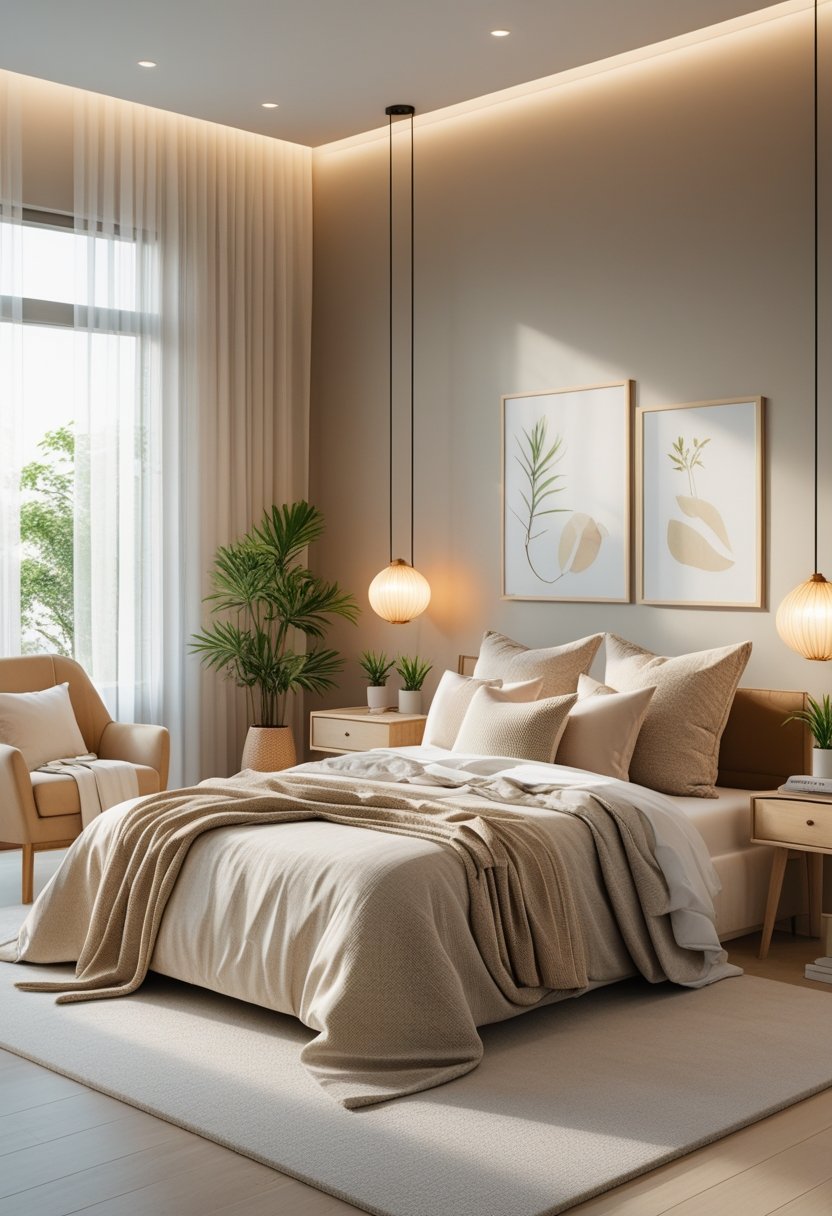
A bedroom designed for wellness emphasizes balance, simplicity, and restful energy. This approach ensures the space supports relaxation, reduces stress, and fosters healthy sleep habits.
Creating a Calming Layout
A calming layout prioritizes open space and functional zoning to avoid clutter and distractions. Furniture should be arranged to allow natural flow, keeping pathways clear and avoiding overcrowding.
Key features include placing the bed away from the door and near natural light sources. Minimalist furniture with clean lines enhances the sense of order and calm.
Soft textiles and neutral color palettes help create a peaceful ambiance. Incorporating layers of ambient lighting supports mood adjustment throughout the day and evening.
Incorporating Biophilic Design Elements
Biophilic design connects indoor spaces with nature using plants, natural materials, and organic shapes. Houseplants improve air quality and add subtle visual interest without overwhelming the room.
Natural wood, stone textures, and woven fabrics provide tactile warmth, contributing to both comfort and aesthetic appeal.
Large windows or skylights maximize daylight, which supports circadian rhythms and improves mental well-being. Even small touches like green accent colors can reinforce this connection to nature.
Tech-Free and Restorative Bedroom Ideas
Removing or reducing electronic devices encourages better sleep and mental rest. Bedrooms designed for restoration typically avoid TVs, computers, and smartphones close to the bed.
Instead, bedrooms use analog clocks, soft lighting, and calming decor, which support a screen-free environment. Charging stations outside the room help minimize distractions.
A focus on sensory comfort, such as blackout curtains and soundproofing, reinforces the room’s purpose as a quiet retreat. These choices ensure the bedroom remains a dedicated zone for rest and rejuvenation.

